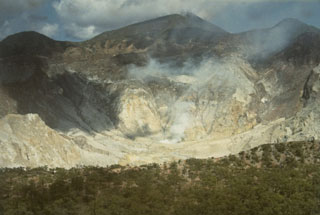Report on Sirung (Indonesia) — 9 May-15 May 2012
Smithsonian Institution / US Geological Survey
Weekly Volcanic Activity Report, 9 May-15 May 2012
Managing Editor: Sally Sennert.
Please cite this report as:
Global Volcanism Program, 2012. Report on Sirung (Indonesia) (Sennert, S, ed.). Weekly Volcanic Activity Report, 9 May-15 May 2012. Smithsonian Institution and US Geological Survey.
Sirung
Indonesia
8.4972°S, 124.1306°E; summit elev. 1347 m
All times are local (unless otherwise noted)
CVGHM reported that on 8 May a three-hour long ash eruption from Sirung was accompanied by loud sounds and incandescence that reached 10 m above the crater. An ash plume rose 3.5 km above the crater and drifted N, producing ashfall up to 4 mm thick near the crater. During 9-12 May white plumes rose 30-50 m above the crater. A sulfur odor was reported in areas up to 3 km away on 12 May. That same day CVGHM raised the Alert Level to 3 (on a scale of 1-4) and recommended that visitors not approach the volcano within a 2.5 km radius.
Based on a report from a ground-based observer and analyses of satellite imagery, the Darwin VAAC noted that on 12 May an ash plume rose to an altitude of 3 km (10,000 ft) a.s.l. and drifted about 95 km SW.
Geological Summary. Sirung is located at the NE end of a volcanic massif with multiple centers that extends 14 km NE from the southern end of Pantar Island. The volcano is truncated by a 2-km-wide caldera whose floor often contains one or more small lakes. Much of the volcano is constructed of basaltic lava flows, and the Gunung Sirung lava dome forms the high point on the caldera's western rim. A number of phreatic eruptions occurred from vents within the caldera during the 20th century. Forested Gunung Topaki, the high point of the volcanic chain, has a small summit crater and lies ~3.5 km SW of the active crater area.
Sources: Darwin Volcanic Ash Advisory Centre (VAAC), Pusat Vulkanologi dan Mitigasi Bencana Geologi (PVMBG, also known as CVGHM)

